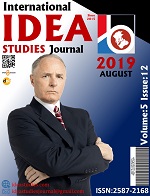Author :
Abstract
Destinasyonlar yoğun rekabet ortamında daha fazla ziyaretçi çekmek ve rakiplerine üstünlük kurabilmek amacıyla sürekli olarak planlamalar yapmakta ve stratejiler geliştirmektedir. Bu planlamaları ve stratejileri geliştirirken destinasyonu diğer destinasyondan ayırt edici özellik olarak kendine özgü kültürel kimliğini ön plana çıkarmaya çalışmaktadırlar. Son yıllarda gastronomi bir seyahat motivasyonu olarak önem kazanmış ve bu konuda gelişmiş olan destinasyonlara ilgi ve ziyaret hızla artmıştır. Her toplumun kendine özgü mutfak kültürü aynı zamanda o milletin millî özelliklerini yansıtmaktadır. Bu çalışmanın konusunu zengin bir mutfak kültürüne sahip olan Giresun İli’nin gastronomik değerleri oluşturmaktadır. Çalışmanın amacı, Giresun’un gastronomi turizmi adı altında kültürel ve geleneksel lezzetlerini belirlemek ve önemine dikkat çekmektir. Araştırmanın amacı doğrultusunda kapsamlı bir alan yazın taraması yapılmış ve Giresun mutfağında ön plana çıkan gastronomik değerler belirlenmiştir.
Keywords
Abstract
Destinations are constantly making plans and developing strategies in order to attract more visitors and gain superiority to their competitors in an intense competitive environment. While developing these plans and strategies, they try to highlight their unique cultural identity as a distinctive feature of the destination from the other destination. In recent years, gastronomy has gained importance as a travel motivation, and interest and visits to destinations developed in this area have increased rapidly. The unique culinary culture of each society also reflects the national characteristics of that nation. The subject of this study is the gastronomic values of Giresun Province which has a rich culinary culture. The aim of this study is to determine the cultural and traditional flavors of Giresun under the name of gastronomic tourism and to draw attention to its importance. In line with the aim of the research, a comprehensive literature review was conducted and the gastronomic values prominent in Giresun cuisine were determined.
Keywords
- Albayrak, A. (2013). Farklı Milletlerden Turistlerin Türk Mutfağına ilişkin Görüşlerinin
- Albayrak, A. (2013). Farklı Milletlerden Turistlerin Türk Mutfağına ilişkin Görüşlerinin Saptanması Üzerine Bir Çalışma. Journal of Yaşar University. 30(8), 5049-5069.
- Anholt, S. (2004). Global Markaların Yere Çuvallamaları. (2. Basım). G. Canan (Çev.) İstanbul: MediaCat Kitapları.
- Çakır, M. (2009). Destinasyon Pazarlamasında Gastronominin Rolü, TÜROFED, 30: 48-50.
- Can A., Sünnetçioğlu, S. ve Durlu-Özkaya, F. (2012). Füzyon Mutfağı UygulamalarınınGastronomi Turizminin Ge- lişimine Katkısı, 13. Ulusal Turizm Kongresi, 6-9 Aralık 2012, Antalya: 873-882.
- Eren, S. (2007). Türk Mutfağı ve HACCP Sistemi; Mutfak Pro- fesyonellerinin Haccp Bilgilerinin Ölçülmesi, I. Ulusal Gastronomi Sempozyumu, 4-5 Mayıs 2007, Antalya, 79-83.
- Gökçe, F., Gökçe, H., Sunar, H. (2017), Dokap Bölgesi Yemekleri; Kiraz Kavurması. 23-24 Ekim2017 Dokap Bölgesi Uluslararası Turizm Sempozyumu Bildiri Kitabı, Karadeniz Teknik Üniversitesi, Ss.559-563.
- Hall, C. M., & Mitchell, R. (2007). Gastronomic tourism: Comparing food and wine tourism experiences. In Niche tourism(pp. 87-102). Routledge.
- Hamlacıbaşı, Fatma Ü. (2008). Yiyecek Turizmi ve Yiyecek Turizmi Açısından Bozcaada’nınKaynakları, (Yüksek Lisans Tezi), Çanakkale: Çanakkale On Sekiz Mart Üniversitesi Sosyal Bilimler Enstitüsü.
- Ignatov, E. (2003). The Canadian Culinary Tourists: How Well Do We Know Them? A thesispresented to the University of Waterloo for the degree of Master of Arts in Recreation and Leisure Studies: Waterloo, Ontario, Canada, 157 p.
- Iyer, P. (2000) The Global Soul, London: Bloomsbury.
- Kivela, J. & Crotts, J. C. (2006). Tourism and gastronomy: gastronomy's influence on how tourists experience a destination. Journal of Hospitality & Tourism Research, 30(3), 354-377.
- Kivela, J. ve Crotts, J.C. (2005). Gastronomy Tourism: A Mea- ningful Travel Market Segment, Journal of Culinary Sci- ence & Technology, 4 (2/3): 39-55.
- Quan, S. & Wang, N. (2004). Towards a Structural Model of the Tourist Experience: An Illustration from Food Experience in Tourism. Tourism Management, 25(3), 297-305.
- Richards, G. (2002). Gastronomy: An essential ingredient in tourism production and consumption? In A.-M. Hjalager & G. Richards (Eds.), Tourism and gastronomy, London: Routledge, 3-20.
- Richards, G. (2002). Tourism Gastronomy. İçinde A-M. Hjala- ger ve G. Richards (Editörler),Gastronomy: and Essential Ingredient in Tourism Production and Consumption? (3-20) Londra: Routledge.
- Richards, G. (2003). Gastronomy: an essential ingredient in tourism production and consumption?. In Tourism and gastronomy (pp. 17-34). Routledge.
- Santich, B. (2004). The study of gastronomy and its relevance to hospitality education and training. Hospitality Management, 23, 15-24.
- Şengül, S., Çakır, A. ve Çakır, G. (2015). Yöresel Mutfaklar, “Trakya Bölgesindeki Yiyecek ve İçecek Mesleki Eğitim Okullarında Kalitenin Artırılması” projesi, Beta Yayınevi.
- Şenol, F. (2016). Türkiye Turizm Coğrafyası ve Dünya Kültürel Mirası, 5. Baskı, Detay Yayıncılık, Ankara. 184-185.
- Tıkkanen, I. (2007). “Maslow’s Hierarchy and Food Tourism in Finland Five Cases”, British Food Journal, Vol:1009, No:9.
- UNWTO (2017) Second Global Report on Gastronomy Tourism, Affiliate Members Report: Volume sixteen.
- Uztuğ, F. ve Konuş, M. K. (2003). Siyasal Marka. (1. Baskı). MediaCat Kitapları. İstanbul.
- Yüncü, H.R. (2010). “Sürdürülebilir Turizm Açısından Gastronomi Turizmi ve Perşembe Yaylası”. 11. Aybastı-Kabataş Kurultayı, Ankara.





